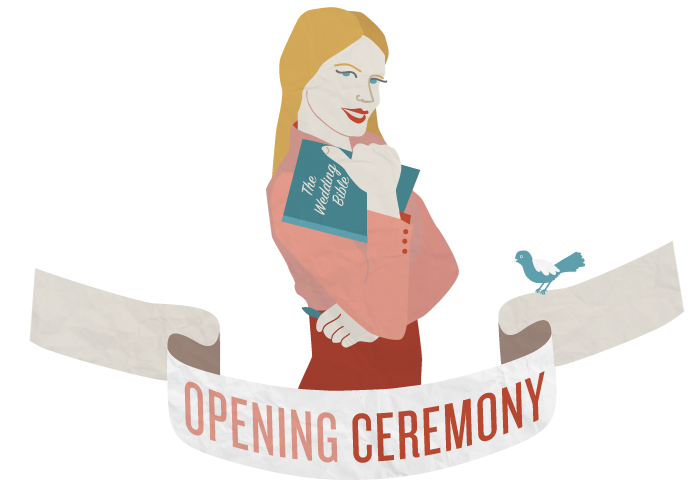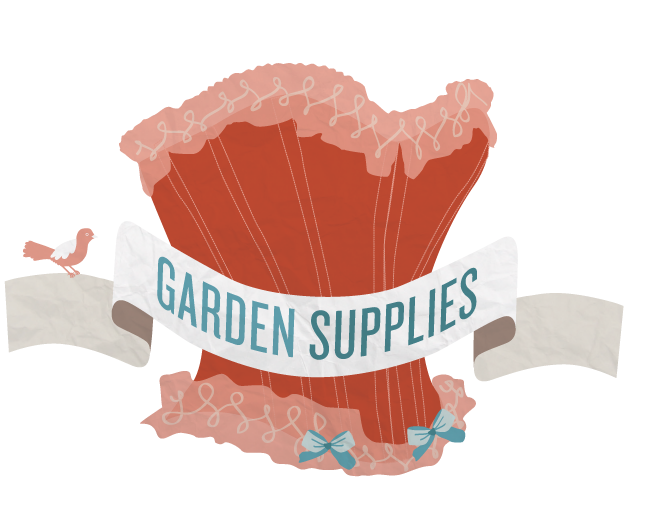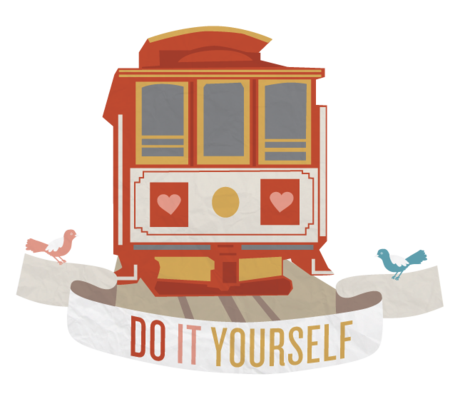

By Sara Faith Alterman
Despite these radical differences, one thing we do agree on (besides that we want to spend our lives together, awww) is that most weddings are stupid and impersonal. When we got engaged last December, we immediately decided to plan a wedding that was a reflection of our very different personalities — and that the whole production couldn’t cost more than a few months’ worth of rent money. After all, we’d like to buy a house someday. Or brand-name peanut butter.
The average American couple drops over $30K on herding friends and families into gaudy hotel ballrooms to eat bad chicken. While not everyone goes the cookie-cutter route, these types of celebrations have come to typify the wedding experience in this country, along with the crinoline doily dress and pastel floral arrangements scattered like Mother Nature’s Easter diarrhea.
Fortunately, we live in San Francisco, the epicenter of counterculture — and, I came to discover, a trove of unique wedding resources that won’t break our budget.


After we figured out our head count for the wedding, Sam and I began looking for a reception venue that reflects San Francisco’s history and its unique architectural styles. We’re New England natives, and we want to give our out-of-town guests a break from all things Colonial.
Walking into One Leidesdorff feels like stepping back in time — or onto the set of Mad Men. What was once a bank is now a venue available for special events, and it is the perfect place to hold, say, a whiskey-soaked, ’60s mod-theme wedding. The main ballroom features gorgeous gold chandeliers, a sweeping round staircase that leads to the second level and, my favorite feature, teller stations that have been converted into a bar. Downstairs, several empty bank vaults can be used for wine tastings, lounges, holding cells for naughty guests, whatever you want. The question is: Are vaults romantic?
My tour guide, corporate sales manager Ben Rodny, insists that he bring me next door to another property owned by the same management company. I resist at first, enchanted by the grandeur of One Leidesdorff. I am agape, however, as we enter the most architecturally splendid edifice in San Francisco, the Merchants Exchange Building.
After surviving the 1906 earthquake and subsequent fires that all but destroyed the city, the Merchants Exchange Building remains a monument to the economic, political, and civic history of San Francisco. Ben brings me up 15 floors to the Julia Morgan Ballroom, named for the woman who designed, among other things, Hearst Castle. This room used to be the men’s-only Commercial Club, whose membership roster boasted the most prominent wheelers and dealers in San Francisco. The city’s twentieth-century history was essentially made here. President Theodore Roosevelt once spoke here. And I could get married here. NO BIG DEAL.
Never mind the fact that this ballroom is steeped in history — I feel like I’m standing inside a box of the fanciest chocolates you can imagine. None of that Walgreen’s Valentine shit. Gazing around at the intricate, hand-carved mahogany ceiling, the 20-foot marble fireplace, and the luxurious carpet, I’m practically drooling. This doesn’t put me in much of a position to negotiate rental rates (which, depending on the season and day of the week, can vary dramatically). I’m having a deco-gasm. Ben just takes it all in stride.


Now that we have a pretty good idea of where we’ll get married, who’s going to marry us? To be honest, I really have no idea, other than that we don’t want a religious ceremony. I’m an atheist Jew/Baptist combo deal; Sam was sort of raised Episcopalian, but not exactly. Jesus makes both of us uncomfortable. Luckily, I’ve got a friend in Amber Milner of Luminous Weddings & Events, whom I’ve known for about a year.
As far as officiants go, Amber is one of a kind. First of all, she’s over six feet tall, and she’s gorgeous. She also isn’t much older than I am, which, even though we’re friends, seems … weird.
And I tell her that when we meet at Cafe Abir to chat about what Sam and I are looking for in a ceremony. She laughs and tells me that, yes, most people associate wedding officiants with old men or butch lesbians in robes.
Amber assures me that she can perform any kind of ceremony we’d like. She has a library of different vows and readings, or we can provide our own. “Some people want a simple ceremony, some people get stuck on having their vows be the most obscure lyrics to the weirdest emo song you’ve ever heard,” she says. “Hey — if you want your hands dipped in wax before you dance around in a circle naked, ok. It’s your wedding.”
Tempting.
To be honest, the idea of standing before a crowd and mumbling scripted sentiments totally freaks me out, and I love that Amber is willing to help us craft our own thing. (Since I’m a writer, I’ll probably write our vows, which gives me the added bonus of making sure that Sam promises to love me, honor me, and buy me a unicorn.) I also like that Amber has a sense of humor about some of the new age-y wedding rituals that are making a comeback. Then there’s the fact that I kind of want to set her up with Sam’s cousin. He’s a physicist who builds boats and is in a band that plays sea shanties. Of course he is.

Since we’ve opted not to dance naked in a circle, I’ll need something to wear. The mere idea of a strapless confection of beads and bows makes me itchy. I want to avoid salesbots who shill overpriced Cinderella gowns, but I don’t want to buy a dress online. I want the experience of going to a dress shop and feeling gorgeous. Billowy white muumuus don’t make me feel gorgeous. But corsets do!
I breeze into Dark Garden, an utter wet dream of Edwardian, Victorian, burlesque, and Steampunk fashions. The Hayes Valley shop specializes in custom corsets and bridal ensembles. I am obsessed with the idea of being laced into my wedding gown — although my mother may pass out in a fit of dismay at the sight of her only daughter traipsing down the aisle tits akimbo.
I pore through the wedding albums and fabric samples, running my fingers sensually (probably creepily) over a swatch of teal satin. Then it’s time to suck it in and get fitted. Have you ever imagined what you would look like with a Kate Moss waist and Anna Nicole Smith boobs? I hadn’t either. And yet, here I am, staring into a full-length mirror, breasts swelling like puffs of bread dough set out to rise on an 80-degree afternoon. We try several styles before I settle on a Dollymop — a more angular bodice that’s cut at 45-degree angles at the waist.
Maybe I’ll get one for Amber, too. Then it will be a sure thing with the shipbuilding sea shanty singer.

Sam actually comes from a long line of New England shipbuilders. Craftsmanship is in his bloodline. Sure, the last thing he built was a pair of speakers for our TV, but they’re crafty speakers. I want him to somehow put those hardy hands to work for the wedding. (And the wedding night. Meow!)
But we don’t need a boat or a subwoofer for the wedding, so what else can Sam craft? An altar? No. Some kind of archway? Ew. Our wedding bands? Hmmm. Fire. Hammers. Metal. So masculine!
But where…how…wha….Oh. We’re in San Francisco. Of course there’s a place we can make our own rings!
I meet with Adam Clark, owner of Scintillant Studios, in his studio/school on Valencia.
For the past 16 years he’s been working with couples to help them design and forge their wedding bands. He takes one look at my 1920s-era white gold engagement ring and cracks a smile. “Your man did a good job,” he says. Yeah!
Together, we go over the history and virtues of white gold — which is not, as commonly believed, an element, but rather a combination of gold and something else. Traditionally, he explains, it was made with 75 percent gold and 25 percent palladium. Adam is a total history nerd, which is the best kind of nerd.
“Most people think they’re allergic to white gold,” he says. “But that’s because around World War II people stopped using palladium.”
He explains that around that time, most white gold was produced by Jewish jewelers, who were secretive about the metals they were combining to create it. A lot of their knowledge was lost in the Holocaust. “Postwar, people got in the habit of using nickel to make white gold,” Adam adds, “and nickel is crappy.”
We talk about design and materials, and Adam shows me some of the big, manly machines that Sam and I will use to melt, densify, shape, and sand our wedding bands. I can’t wait to dive in.
To me, the ring is the absolute symbol of marriage and the thing I’ll have to look at every day for the rest of my life. Besides my husband, of course.

Have a fairy tale wedding rich with local history at One Leidesdorff or the Julia Morgan Ballroom. Let Amber Milner of Luminous Weddings & Events tailor a wedding ceremony that’s a perfect reflection of you and your spouse. Make your own wedding ring with Adam Clark of Scintillant Studio.
Design: Jess Taich







